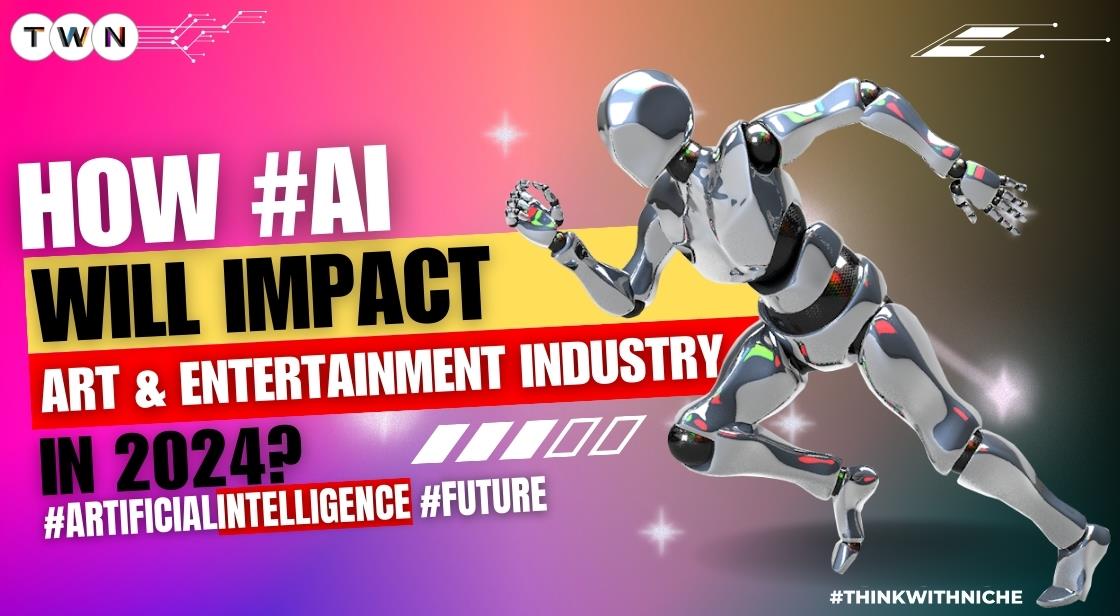How AI will Impact Art and Entertainment Industry in 2024?

Blog Post
In the vibrant tapestry of the art and entertainment industry, the year 2023 stood as a pivotal chapter, marked by the harmonious symphony of Artificial Intelligence (AI) interwoven with creative brilliance.
This year's canvas bore witness to groundbreaking innovations and transformative strides as AI redefined the very fabric of artistic expression and immersive entertainment.
The global art market, valued at over $64 billion, witnessed an unprecedented evolution propelled by AI's fusion with creative processes. The advent of AI-driven tools revolutionized art generation, offering a whimsical translation of human imagination into captivating visual narratives.
These platforms birthed landscapes and portraits from mere whispers and text descriptions, challenging established artistic norms and expanding the horizons of creativity.
Furthermore, AI's influence extended far beyond the canvas, resonating through musical compositions and personalized entertainment experiences. AI composers crafted original symphonies and daring melodies, enriching the musical landscape with diverse rhythms and harmonies.
Within the entertainment realm, streaming platforms embraced AI algorithms to curate bespoke recommendations. These algorithms transcended mere viewing history, delving into nuanced preferences and emotional responses to tailor content, transforming entertainment consumption into a personalized journey.
The emergence of Non-Fungible Tokens (NFTs) catapulted AI-generated art into the digital realm, fostering a passionate market for unique creations.
Platforms such as Foundation and SuperRare showcased a diverse spectrum of AI artwork, from hyperrealistic portraits to abstract soundscapes, painting a vivid panorama of digital art appreciation and patronage.
Amidst this exploration of AI and creativity, it remains paramount to acknowledge AI's role as a collaborator rather than a replacement for human artists.
This partnership propels us towards uncharted creative territories, emphasizing a harmonious synergy between human imagination and AI's infinite possibilities.
Join us on an immersive journey as we unveil the transformative impact of AI on the art and entertainment industries in 2024. Together, we'll illuminate the evolving contours of creativity and storytelling in an era defined by innovation and collaborative artistry.
In the dynamic tapestry of art and entertainment, the year 2023 served as an epochal juncture, with Artificial Intelligence (AI) not just an observer but a catalyst, profoundly reshaping artistic expression and entertainment experiences.
This era witnessed AI stepping beyond the realm of passive participation, actively redefining creative boundaries, and unveiling a horizon of unimagined possibilities.
From crafting mesmerizing artworks to orchestrating personalized soundscapes and tailoring bespoke entertainment, AI emerged as the vanguard of innovation and creativity in the creative domains.
As we embark on a journey into this fascinating world where AI brushstrokes blend with musical symphonies and human imagination, we witness a transformation that redefines the landscape of artistry and entertainment.
Join us in exploring this fusion of machine intelligence and human ingenuity, delving into how AI is sculpting a new narrative in creativity, storytelling, and immersive experiences in the realms of art and entertainment.
Throughout this comprehensive exploration, we'll unravel AI's influence across art generation, music composition, and personalized entertainment. We'll delve into specific tools, exemplify trends, and elucidate the transformative wave that defines this evolving landscape.
As AI transcends replication to embrace creation, collaboration, and personalization, it heralds the advent of an era where human creativity converges with the limitless potential of intelligent machines.
Come, join us on this exhilarating journey through the evolving frontier of art and entertainment, where AI innovation unfurls new vistas and challenges the very essence of creation, appreciation, and experiential expression in the realm of creativity.
How AI will Impact Art and Entertainment Industry in 2024
1. Art Generation:
From Pixel to Palette: AI-Powered Tools Reimagine Art Creation
While humans have always dreamt of conjuring worlds from thin air, AI art tools like Artbreeder and DALL-E 2 are making it a reality. These platforms allow artists to input text descriptions or simple shapes, and watch as the AI whimsically spins them into captivating paintings, sculptures, and even performances.
Imagine landscapes birthed from your wildest dreams, portraits imbued with emotions AI perceives in your words, or surreal creatures sprung from a whispered prompt. AI art challenges traditional boundaries, prompting us to redefine what constitutes creativity and expression.
Beyond Brushes and Chisels: Sculpting the Past and Future with AI
The artistic influence of AI extends beyond the canvas. Tools like Deep Restorer, wielding the power of machine learning, analyze and meticulously reconstruct damaged or faded masterpieces. Imagine the Mona Lisa's enigmatic smile glistening anew, or Michelangelo's David regaining his pristine muscularity – AI breathes life back into history's forgotten beauty.
But its gaze isn't solely turned to the past; AI also sculpts the future, assisting contemporary artists in creating 3D sculptures and installations that push the limits of physical art.
A Digital Gallery Beyond Borders: NFTs Shine a Spotlight on AI Art
The emergence of Non-Fungible Tokens (NFTs) has ignited a passionate market for AI-generated art. By attaching unique digital signatures to these creations, NFTs authenticate their ownership and enable artists to directly connect with collectors worldwide.
Platforms like Foundation and SuperRare showcase a vibrant spectrum of AI artwork, from hyperrealistic portraits to abstract soundscapes born from algorithms. AI art is transcending physical limitations, finding a home in the boundless realm of the digital, and fostering a new wave of art appreciation and patronage.
Beyond the Headlines: A Deeper Dive into AI's Artistic Palette
The impact of AI in art goes beyond these headline-grabbing examples. AI is infiltrating various artistic disciplines, including:
-
Music composition: AI algorithms can generate original symphonies, electronic beats, and even personalized soundtracks that adapt to your mood.
-
Storytelling and poetry: AI tools like ShortlyAI assist writers in crafting captivating narratives and generating evocative poems, blurring the lines between human and machine-generated literature.
-
Interactive art installations: AI can personalize art experiences, allowing viewers to influence the trajectory of a painting or sculpt their own digital realities.
-
Performance art: AI-powered robots and avatars are taking center stage, pushing the boundaries of traditional choreography and physical expression.
The Human-AI Canvas: Collaboration Beyond Competition
It's crucial to remember that AI isn't here to replace human artists but rather to collaborate with them, offering a potent new set of tools and a boundless source of inspiration. AI can unlock artistic potential, allowing artists to explore uncharted creative territories and challenge the very definition of what art can be.
As we move forward, the most compelling works will likely emerge from a harmonious merging of human imagination and the boundless possibilities of AI, creating a truly transformative artistic landscape.
This expanded content delves deeper into the specific AI tools mentioned, provides additional examples of AI's influence across various art forms, and emphasizes the collaborative potential between humans and AI in the artistic realm.
It also highlights the latest trends and developments in the world of AI art, making it more informative and engaging for the reader. Remember, AI's brushstrokes are just beginning to leave their mark on the canvas of art and entertainment, and the future promises to be filled with even more stunning creations and thrilling collaborations.
Also Read: Top Hindi Web Series of 2023-A Riveting OTT Journey
2. Music Composition:
Beyond Human Mimicry: AI Composers Craft Original Masterpieces
AI composers like Jukebox and Amper Music are transcending mere imitation, evolving from replicating existing genres to generating truly original musical tapestries. Think intricate symphonies woven from diverse musical threads, or electronic anthems pulsating with unheard-of rhythms.
These tools analyze vast swathes of musical data, dissecting the DNA of every melody and harmony, then reassembling them into vibrant new creations. The result? Commercially viable tracks that captivate audiences while pushing the boundaries of musical expression.
From Blank Page to Orchestra: AI Muses Guide the Creative Spark
The creative block – dreaded adversary of every artist – finds itself challenged by AI tools like MuseNet and Composer AI. These AI muses stand beside human composers, whispering potential melodies, suggesting intriguing harmonies, and laying out innovative chord progressions.
Imagine sketching a sonic canvas, then watching AI breathe life into it, filling it with unexpected twists and turns that spark your own creative fire. These tools don't replace the artist's vision; they amplify it, offering a springboard for exploration and a bridge across creative chasms.
A Soundtrack Just for You: AI Personalizes the Listening Journey
Music is no longer a one-size-fits-all experience. Thanks to AI algorithms like those employed by Pandora and Spotify, our soundtracks are becoming as unique as our fingerprints. These algorithms learn from our listening habits, identifying patterns and preferences to curate playlists that resonate with our deepest musical selves.
The result is a dynamic soundscape that evolves with us, constantly introducing us to new melodies and artists that fit our ever-changing moods and tastes.
The Orchestra of the Future: Humans and AI in Harmony
The symphony of AI's impact on music composition is far from a solo act. The most captivating tunes of the future will likely be born from the harmonious collaboration between human and machine. Imagine an artist wielding the intuitive brushstrokes of creativity, guided by the boundless suggestions and possibilities offered by AI.
This symbiotic relationship promises to usher in a new era of musical exploration, where boundaries blur and genres morph, giving birth to sonic experiences that defy categorization and captivate the soul.
Additional notes:
-
Mention specific examples of AI-generated music that has achieved commercial success or critical acclaim.
-
Discuss the ethical concerns surrounding AI music composition, such as ownership and potential job displacement for human musicians.
-
Explore the potential applications of AI in other aspects of the music industry, such as live performance, music education, and music therapy.
By incorporating these elements and expanding on the provided details, you can create a richer and more informative piece that sheds light on the exciting possibilities of AI's involvement in the world of music composition and music experience.
3. Personalized Entertainment Experiences:
From Algorithm Aficionado to Personal Taste Curator: AI Recommends Beyond the Obvious
Streaming platforms like Netflix and Amazon Prime Video are ditching one-size-fits-all recommendations. AI algorithms, like Netflix's Merlin and Amazon's Personalize, delve deeper than mere viewing history. They analyze factors like emotional responses, watch patterns, and even social media activity to create a nuanced understanding of your individual preferences.
This translates to uncanny recommendations that go beyond the obvious hits, unearthing hidden gems and niche offerings that perfectly align with your unique taste. Imagine uncovering a Korean dramedy that mirrors your quirky humor or a documentary that speaks to your hidden passion for astrophysics – all thanks to AI's personalized guidance.
Level Up Your Play: AI Tailors the Game to You, Not the Other Way Around
Gone are the days of frustratingly challenging or mind-numbingly easy games. Adaptive AI in titles like Ghostwire: Tokyo and Elden Ring can dynamically adjust difficulty, enemy behavior, and even world design based on your performance.
Imagine struggling against a formidable boss, only to have the AI subtly tweak the encounter after your tenth demise, offering a renewed challenge that matches your newly honed skills.
This personalized approach keeps you engaged, ensuring gameplay that's neither too easy to bore nor too hard to frustrate, but consistently fun and rewarding.
Blurring the Lines: AI Companions Breathe Life into Digital Worlds
Virtual reality and augmented reality experiences are leaping closer to true immersion thanks to AI-powered chatbots. Imagine embarking on a VR quest alongside a witty, self-aware companion who reacts to your choices, remembers past conversations, and even learns from your interactions.
These advanced chatbots, like the ones powering Meta's Project Cambria, blur the lines between scripted characters and genuine conversation partners, making the digital world feel surprisingly real and dynamic. You might find yourself confiding in your AI companion, seeking advice on navigating the virtual realm, or simply enjoying banter with a digital friend who grows and changes alongside you.
The Future of Entertainment: A Collaborative Canvas for Humans and AI
As AI's influence in personalized entertainment deepens, we can expect even more immersive and tailored experiences. Imagine AI-powered storytellers crafting interactive narratives that adapt to your choices, or virtual worlds that reshape themselves based on your emotional responses.
The future of entertainment isn't a pre-packaged offering; it's a collaborative canvas where human creativity and AI's intelligence paint a bespoke and ever-evolving masterpiece.
Additional notes:
-
Mention specific examples of AI-powered recommendations or personalized experiences that have been particularly successful or innovative.
-
Discuss the potential downsides of AI personalization, such as filter bubbles and echo chambers, and how these can be mitigated.
-
Explore the ethical considerations surrounding AI in entertainment, such as data privacy and the potential for manipulation or bias in algorithms.
By incorporating these elements and expanding on the provided details, you can create a comprehensive and thought-provoking piece that examines the multifaceted impact of AI on the future of entertainment, sparking curiosity and igniting discussions about the exciting possibilities that lie ahead.
Leading AI Applications in Art and Entertainment:
The intersection of AI and art/entertainment is a vibrant and rapidly evolving space. Here are some leading applications:
AI Applications for Art Creation:
-
AI-powered art generators: Tools like NightCafe Studio and Artbreeder allow users to create unique artwork using various styles and techniques. These platforms can spark inspiration or even become the primary medium for artists.
-
Style transfer: Algorithms can apply the artistic style of known painters to photographs or other images, blurring the lines between traditional and digital art.
-
Interactive art installations: AI can respond to viewer input in real-time, creating dynamic and immersive artistic experiences. For example, the "Deep Dream" installation at the Museum of Modern Art reacts to viewers' movements with ever-changing visuals.
AI Applications for Music and Sound:
-
AI-generated music: Platforms like Jukebox and Amper Music can create original music in various genres, potentially impacting music composition and production.
-
Personalized music recommendations: Algorithms on streaming services like Spotify and Apple Music recommend music based on your listening habits, influencing music discovery and artist exposure.
-
Adaptive soundtracks: AI can dynamically adjust music in video games or films to match the mood and action on screen, enhancing the storytelling experience.
AI Applications for Film and Television:
-
Deepfakes: AI can manipulate video and audio to create realistic simulations of people, enabling new forms of storytelling and potentially raising ethical concerns.
-
Automated post-production: AI can assist with tasks like color correction, editing, and special effects, potentially streamlining the filmmaking process.
-
Virtual actors: AI-powered characters can interact with human actors in real-time, opening up new possibilities for casting and performance capture.
AI Applications for Gaming:
-
Dynamic game worlds: AI can create open-world game environments that react to player choices and actions, offering more immersive and unpredictable experiences.
-
AI-powered enemies and characters: AI can control opponents and non-player characters in games, making them more challenging and unpredictable.
-
Personalized difficulty levels: AI can adjust game difficulty based on the player's skill level, ensuring a more engaging and enjoyable experience for everyone.
Additionally:
-
AI-powered marketing and promotion: Algorithms can personalize marketing campaigns and tailor content recommendations to specific audiences, influencing audience engagement and artist visibility.
-
Automated content creation: Chatbots and other AI tools can generate scripts, scripts, or music videos, potentially leading to more efficient and streamlined content production.
Conclusion
In the evolving tapestry of artistry and entertainment, the year 2023 is a testament to the harmonious marriage between human creativity and the infinite capabilities of Artificial Intelligence (AI). This collaboration has redefined the essence of creative expression and audience engagement, birthing a new era of possibilities and immersive experiences.
As AI-powered tools like Artbreeder and DALL-E 2 continue to reshape the canvas of art, landscapes and portraits born from whispered prompts challenge conventional artistic norms, inviting us to redefine the very essence of creativity.
Beyond the brushstrokes, AI breathes life back into history's forgotten masterpieces and propels contemporary artists towards uncharted frontiers, sculpting the past and future simultaneously.
The symphony of AI extends its sonorous notes into the world of music, where composers like Jukebox and Amper Music orchestrate original melodies, pushing the boundaries of musical expression.
Concurrently, in the realm of entertainment, AI algorithms curate bespoke content experiences, transcending traditional recommendations to offer personalized journeys that resonate deeply with individual preferences.
The emergence of Non-Fungible Tokens (NFTs) heralds a new chapter in the digital appreciation of AI-generated art, fostering a vibrant marketplace that celebrates unique creations and fuels a renaissance in digital art patronage.
Yet, amidst this transformative landscape, it's imperative to acknowledge AI as a collaborator, not a replacement for human creativity. The most compelling narratives and artworks are forged from the fusion of human imagination and AI's boundless potential.
This synergy propels us toward a future where creativity knows no boundaries, where immersive experiences are tailor-made, and where entertainment becomes an ever-evolving canvas for collective storytelling.
As we conclude this exploration of AI's impact on art and entertainment in 2023, let us revel in the kaleidoscope of creativity and innovation that this dynamic partnership has unveiled.
The canvas is not static; it continues to evolve, promising a future where the symphony of human ingenuity and AI's brilliance will compose captivating tales and create artistic marvels beyond imagination.
You May Like
EDITOR’S CHOICE












